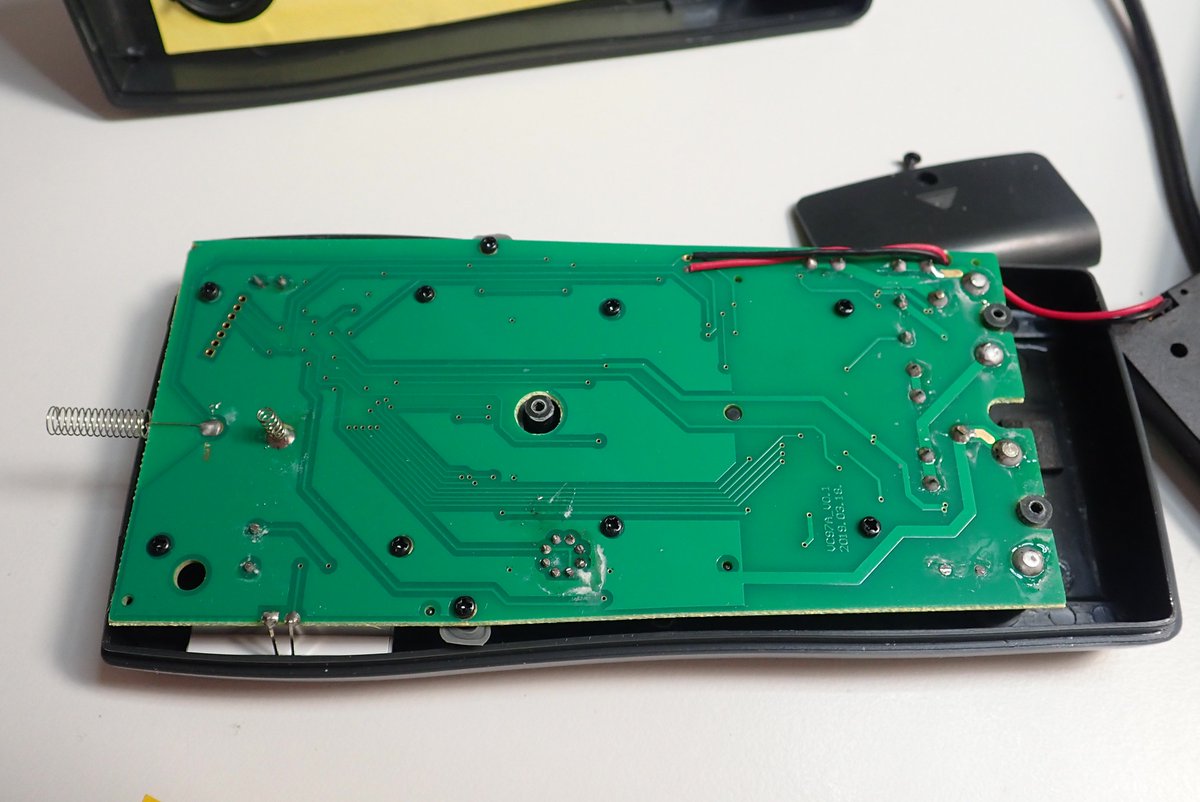A multimeter is one of the most fundamental tools when working in electronics and hardware hacking. The market is totally saturated these days, with meters ranging from £5 up to £1000.
Let& #39;s take a look at a few of them.
This is a VC97A - they are sold under a lot of brands
Let& #39;s take a look at a few of them.
This is a VC97A - they are sold under a lot of brands
Notice it has a hFE socket (the round one top right) for characterising transistors. IMHO, avoid meters with these. You won& #39;t use it, firstly.
But on these cheap meters, the hFE socket is NOT isolated from the main terminals. And that is the case here.
15Ω from common to base.
But on these cheap meters, the hFE socket is NOT isolated from the main terminals. And that is the case here.
15Ω from common to base.
The same is true with meters that have their own type-K thermocouple socket.
On this bad boy, the - temp probe input is directly connected to common.
If you left a thermocouple plugged in and then measured mains voltage, there is the potential for the thermocouple to be live!
On this bad boy, the - temp probe input is directly connected to common.
If you left a thermocouple plugged in and then measured mains voltage, there is the potential for the thermocouple to be live!
Bit of a weird meter inside, you can& #39;t see any of the fuses or anything. You need to unscrew the PCB. It& #39;s just two screws, but they don& #39;t tell you which ones.
Popping the VC97A open, it has an antenna!
Why? For non-contact voltage detection.
I wish meters didn& #39;t have this. It& #39;s someone useful on a small pen probe, but not on a giant hulking meter.
Why? For non-contact voltage detection.
I wish meters didn& #39;t have this. It& #39;s someone useful on a small pen probe, but not on a giant hulking meter.
Input protectuon is sparse on this meter. A PTC on the V input, and glass fuses on the A and mA.
Glass fuses don& #39;t like extreme overcurrent and tend to physically explode, or, worse still, not actually break the circuit.
Glass fuses don& #39;t like extreme overcurrent and tend to physically explode, or, worse still, not actually break the circuit.
Another annoyance with this meter is that the continuity function is a secondary one, and it doesn& #39;t remember. Each time it powers off, or you change range, you need to press this button.
Another cheap meter. The AstroAI DT132A.
Notice it only has one current terminal - we& #39;ll come onto why this is bad!
Notice it only has one current terminal - we& #39;ll come onto why this is bad!
At least this one has ceramic fuses in it. They aren& #39;t huge, but probably better than glass.
So, I want to measure current. I& #39;ve set my PSU to 200mA ish, and I swap the probes to the "A".
Not bad, but I might want to get more resolution. Let& #39;s switch to mA on the dial.
Not bad, but I might want to get more resolution. Let& #39;s switch to mA on the dial.
3.06mA? That& #39;s not right.
This is HORRIBLE from a safety perspective. One click of the dial changes a high-impedance input into a low-impedance. If you were measuring a source capable of providing a lot of energy, this could mean a very big bang!
Nasty. Although this meter claims CAT III 300V, I would not want to use this on a mains appliance never mind distribution.
And just look at the size of that fuse! This is a HRC (High Rupture Capacity) fuse.
It won& #39;t explode and can interrupt much higher fault currents.
It won& #39;t explode and can interrupt much higher fault currents.
Internally, it is much more complex. The secondary board contains a range of protection devices, as well as the split terminals on the probes that loudly warn you if you are trying to measure voltage with the probes in A/mA.
As a result, this meter is rated at CAT III 600V - enough to work on three phase distribution in a building. Although two-pole testers are considered better now.
Another decent meter, AM-140-A. CAT III 1000V. It& #39;s also CAT IV 300V - i.e. you could use this on the incomer to a building.
There& #39;s another meter that I have that claims CAT IV 600V. It& #39;s a Tenma (Farnell rebadge brand) one.
This one does quite a few cool things, like display frequency at the same time as current. But let& #39;s look inside.
I honestly don& #39;t believe this meter is safe on CAT IV installations.
It& #39;s actually a Unitrend UT-71D, and I raised it with Farnell.
https://www.uni-trend.com/html/product/General_Meters/Digital_Multimeters/UT71_Series/UT71D.html">https://www.uni-trend.com/html/prod...
It& #39;s actually a Unitrend UT-71D, and I raised it with Farnell.
https://www.uni-trend.com/html/product/General_Meters/Digital_Multimeters/UT71_Series/UT71D.html">https://www.uni-trend.com/html/prod...
There are other things worth checking on a meter.
Is it accurate and does it have a high enough resolution?
On the whole, most digital meters are OK.
Is it accurate and does it have a high enough resolution?
On the whole, most digital meters are OK.
One thing that isn& #39;t always obvious is how the "count" can impact the resolution you get. On the VC97A, it is only 3999 count - so when measuring 5V, we can& #39;t use the most significant digit.
The AM-140A can go into a super high count mode. It& #39;s very slow
One other thing worth checking is the voltage used in continuity mode. Most are around 1.7V, but some only use 0.5V or so.
So, in summary? I& #39;ve bought a lot of cheap meters over the years for various people to use. Most of them are crap in some way, many of them are unsafe to use around mains voltages.

 Read on Twitter
Read on Twitter




























